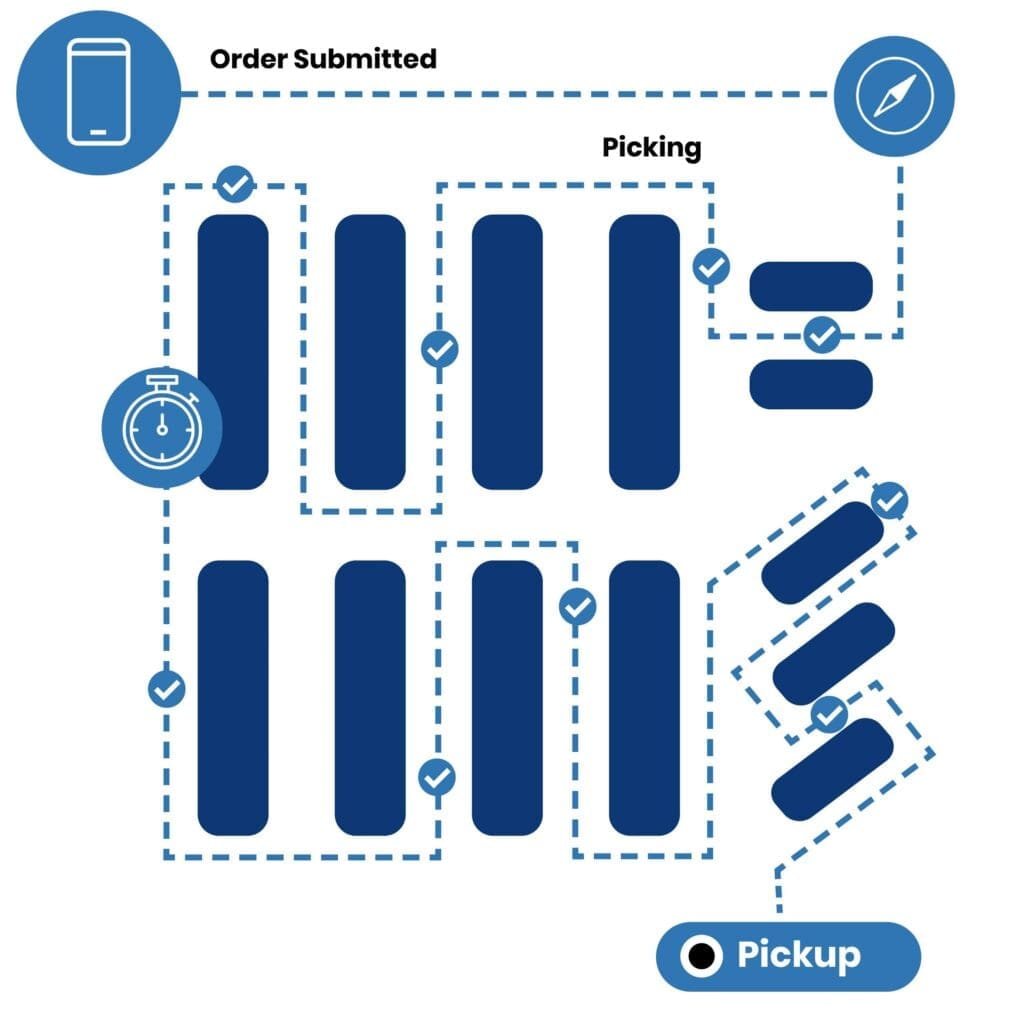
6 Ways to Increase Profitability through Grocery eCommerce Operations
3… 2… 1… Liftoff!
Launching a grocery eCommerce platform might not be quite as thrilling as a space shuttle launch, but for a grocery business about to extend its services from in-store to shopping online, the process is filled with excitement and anticipation.
Every step—planning, selecting the right technology, choosing the platform, testing, and finally going live—feels like a monumental achievement. And just like a space mission, the launch is only the beginning.
The true challenge begins once the countdown reaches zero.

With the rapid growth of online grocery shopping, many grocers have already entered the online grocery market and implemented a grocery eCommerce platform. As online grocery sales have stabilized, however, grocers are increasingly looking to expand their online grocery businesses further and increase profitability.
That requires streamlining their eCommerce grocery store operations.
While there’s a wealth of advice available to grocers on starting a grocery eCommerce business, the guidance typically trails off when it comes to optimizing the operations to make an online grocery business more profitable.
To ensure your eCommerce operations drive profitability, it’s crucial to focus on continuous improvement, efficiency, and adaptability. In this article, we’ll explore six practical strategies to help grocery retailers enhance their eCommerce operations and ensure long-term growth.
Bridging the Gap between Theory and Practice in Online Grocery Shopping
There’s a common misconception in the grocery industry that grocery eCommerce can’t be profitable, but this is simply not true.
Profitability is absolutely achievable. But it takes work. It requires a deep understanding of operations and a strategic approach to addressing inefficiencies.
A contributing factor to this common misconception in the grocery industry is the general lack of practical advice readily available to grocers when it comes to making grocery eCommerce profitable.
While theoretical advice on grocery eCommerce strategies abounds, grocery retailers seldom get the practical, actionable insights they need to get the most out of their tech investment.
It’s one thing to know that you need to improve efficiency; it’s another to understand how to do it within the specific constraints and capabilities of your business.
Operational optimization isn’t a one-size-fits-all solution. It requires a deep understanding of your store layout, staff capabilities, customer behavior, and technology stack. Only by bridging the gap between theory and practice can grocery stores effectively enhance their eCommerce operations.
6 Ways to Improve Operational Efficiency and Ensure Ongoing Profitability for an Online Grocery Business
To help grocery retailers navigate the complexities of grocery eCommerce, we’ve identified six key strategies that can significantly improve operational efficiency and contribute to long-term profitability.
Some of these tactics might seem small, but they quickly add up to offer big savings to grocery businesses.
1. Optimize Pick Path and In-store Routing
In grocery eCommerce, time is money.
Every step taken by a picker directly impacts both labor costs and order fulfillment times. That puts a lot of pressure on fulfilling online orders from grocery shoppers as efficiently as possible.
One of the most effective ways to enhance picking efficiency is by optimizing the pick path—the route that pickers take through the store to gather items.
A well-planned pick path reduces the time pickers spend moving around the store, minimizes the risk of errors, and ensures faster order completion.
To achieve this, grocers should invest in training pickers on store layouts, use technology to map out the most efficient routes, and regularly review and adjust these routes based on store layout changes or new product placements.
By reducing the distance pickers need to travel, grocers can cut down on labor time and increase the number of orders fulfilled per hour—key metrics that directly influence profitability.
2. Implement Batch Picking and Multi-Picking Techniques
The “time is money” mentality is particularly important during peak times.
Batch picking—where multiple orders are picked simultaneously—can greatly enhance picking efficiency, especially when the volume of online orders is at its highest. This method reduces the number of trips across the store, allowing pickers to gather items for several orders in a single pass.
Think of batch picking as the grocery equivalent of carpooling: instead of making individual trips for each order, pickers can “carpool” by gathering items for several orders at once. This not only speeds up the picking process but also reduces labor costs, as fewer staff are needed to fulfill the same amount of orders.
For even greater efficiency, grocers can implement multi-picking techniques, where multiple pickers work together to fulfill large volumes of orders simultaneously. By coordinating their efforts, pickers can cover more ground quickly, ensuring that during high-volume periods, orders are fulfilled on time.
By optimizing labor in this way, retailers can also open up more delivery or pickup slots, boosting revenue potential. However, it’s crucial to maintain accuracy when batch-picking, as mistakes can lead to customer dissatisfaction and increased costs.
3. Ensure Order Accuracy When Online Grocery Sales Peak
While the optimization of online shopping operations is vital to profitability, it can’t be done at the cost of customer experience. These tips are meant to create faster service standards that will encourage repeat business, not hinder it.
It’s important to keep this in mind, especially when grocery eCommerce sales are at their highest.
High order volumes can strain even the most efficient eCommerce operations, leading to mistakes that quickly erode customer trust and the grocery retailer’s profitability. Ensuring order accuracy is critical, especially during peak times when the pressure is on to fulfill orders quickly.
Investing in the right equipment and eCommerce grocery software—such as barcode scanners and mobile devices that integrate with your inventory management system—can help maintain accuracy without sacrificing speed.
Additionally, regular staff training and clear communication of best practices can ensure that pickers and packers are equipped to handle the demands of high-volume periods.
Remember, every incorrect order costs you in terms of refunds and returns anddamages your reputation. Accuracy should never be compromised for an online business, even when speed is of the essence.
4. ‘Bag As You Go’ to Reduce Labor Costs
We’ve already emphasized the importance of equating time to money when it comes to streamlining the grocery eCommerce process, specifically in the picking process.
This aspect of online grocery shopping operations further applies to the handling of products.
Every time a product is touched, it translates into labor costs. If pickers are spending too much time handling products, this inefficiency adds up quickly.
It’s estimated it takes three seconds every time an item is handled.
That’s three seconds to remove a product from the shelf and place it into a cart. If that cart is then taken to a staging area, the product is touched again to move it onto a staging table—adding another three seconds. Finally, when the product is bagged, that’s another three seconds of handling.
This means each product is handled—at best—three times, consuming at least nine seconds in total. If an average order consists of 32 items, this process alone can take nearly five minutes just in handling time.
However, by minimizing these touches, two-thirds of that time can be eliminated. Over the course of fulfilling 20 orders, a simple adjustment can save around one hour of labor, directly reducing operational costs.
That simple adjustment is the bag-as-you-go approach, where items are bagged directly during the picking process.
This minimizes handling, reduces the time spent on each order, and lowers labor costs. By cutting out unnecessary steps, grocers can streamline the fulfillment process, making it faster and more cost-effective.
Over time, the labor savings from this approach can be significant, especially when scaled across a large number of orders. It’s a simple yet powerful way to improve operational efficiency and profitability for online grocery stores.
5. Leverage Data to Optimize Labor Costs of Online Grocery Shopping
Data is an invaluable asset in optimizing grocery eCommerce.
By analyzing key performance indicators (KPIs) such as pick time, order accuracy, and labor costs, grocers can identify areas for improvement and make data-driven decisions to enhance efficiency across all their grocery eCommerce processes.
One effective way to use online grocery data is by implementing an internal scorecard system that tracks labor efficiency and performance.
A simple red light, yellow light, green light system can be used to communicate performance expectations to staff, with green indicating optimal performance, yellow indicating areas for improvement, and red signaling a need for immediate action.
Regularly reviewing these metrics allows grocers to adjust staffing levels, refine processes, and ensure that labor costs remain in line with operational goals.
In a highly competitive market, the ability to optimize labor costs through data-driven insights can make a significant difference to the bottom line.
6. Gain Team Buy-in Through Communication and Training
No optimization strategy will succeed without the support and buy-in of the team responsible for executing it within the actual grocery stores.
Effective communication and comprehensive training are essential for gaining team buy-in and ensuring that all grocery eCommerce processes run smoothly.
Grocers should elevate the status of eCommerce roles within the organization, making these positions desirable and rewarding for staff. Tying incentives, such as bonuses, to online shopping KPIs can further motivate team members to contribute to the success of the grocery eCommerce platform.
Training is equally important. Staff should be equipped with the knowledge and skills needed to excel in their roles, from picking and packing to customer service.
Regular training sessions, combined with clear communication of the importance of eCommerce to the business, can help build a team that is committed to driving operational excellence for a grocery eCommerce business.
Measuring Success: Key Metrics for Evaluating eCommerce Efficiency and Profitability
As mentioned above, optimizing eCommerce operations is an ongoing process that requires continuous monitoring and adjustment.
To ensure that the online grocery strategies outlined above are having the desired impact, grocers need to track key metrics that provide insights into operational efficiency and profitability.
Essential KPIs to monitor include:
- Order Accuracy: The percentage of orders fulfilled correctly, without errors or omissions.
- Labor Costs: The total labor costs associated with eCommerce operations, including picking, packing, and delivery.
- Pick Time: The average time taken to pick an order, from start to finish.
- Order Fulfillment Speed: The time taken from order placement to delivery or pickup.
- Customer Satisfaction: Feedback from customers regarding their eCommerce experience, including ease of use, order accuracy, and delivery speed.
In addition to tracking these metrics, grocers should develop a fully loaded eCommerce Profit & Loss (P&L) statement.
This detailed financial document should account for all costs associated with online grocery store operations, including labor, equipment, technology, and overheads. Creating an eCommerce-specific budget is also crucial, ensuring that resources are allocated efficiently and that profitability is closely monitored.
How Mercatus Bridges the Gap Between Implementation and Ongoing Profitability
Optimizing eCommerce operations is a complex, ongoing process that requires a holistic approach.
From refining pick paths and implementing batch picking techniques to leveraging data for cost optimization and securing team buy-in, every aspect of the operation must be carefully managed to ensure sustained profitability.
By embracing the tactics shared in this article and committing to continuous improvement, grocery retailers can turn their eCommerce platforms into powerful engines of growth and profitability.
And with the right support, grocers can navigate the challenges of eCommerce with confidence, knowing they have the support needed to succeed.
At Mercatus, we’re not just a tech provider—we’re a technology partner. That means we understand that the journey to eCommerce profitability doesn’t end with the launch of a platform.

It’s why the commitment we make with all of our retail partners goes beyond providing an eCommerce solution—and extends into working closely with our clients to ensure continuous growth and profitability.
Through dedicated support, communication of best practices, and ongoing training, Mercatus helps grocery retailers optimize their eCommerce operations, reduce online grocery costs, and enhance customer satisfaction. We provide both the tools and expertise needed to turn online grocery shopping into a long-term driver of profitability that sees your grocery business thrive.
If you’re ready to optimize your eCommerce operations, reach out to us today and see how Mercatus can help you achieve profitability.
 Newsroom
Newsroom
